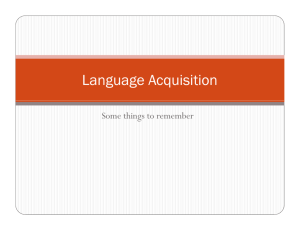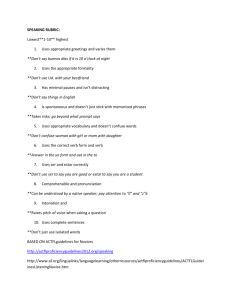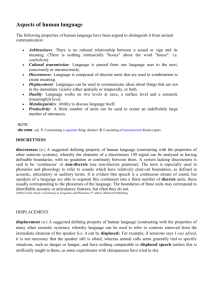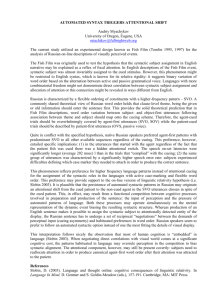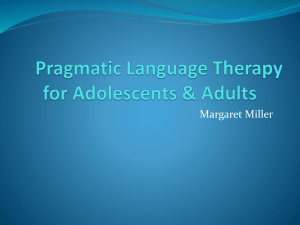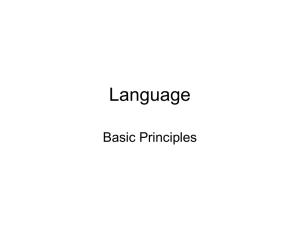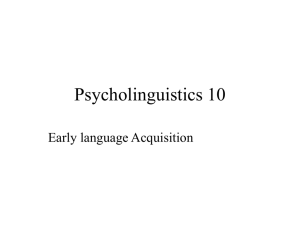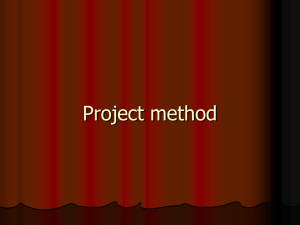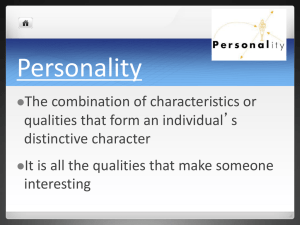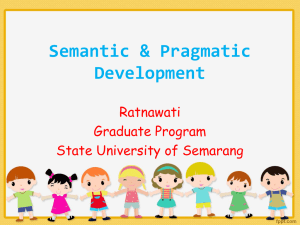Chapter 07-08 Language Development (Daniel`s slides)
advertisement
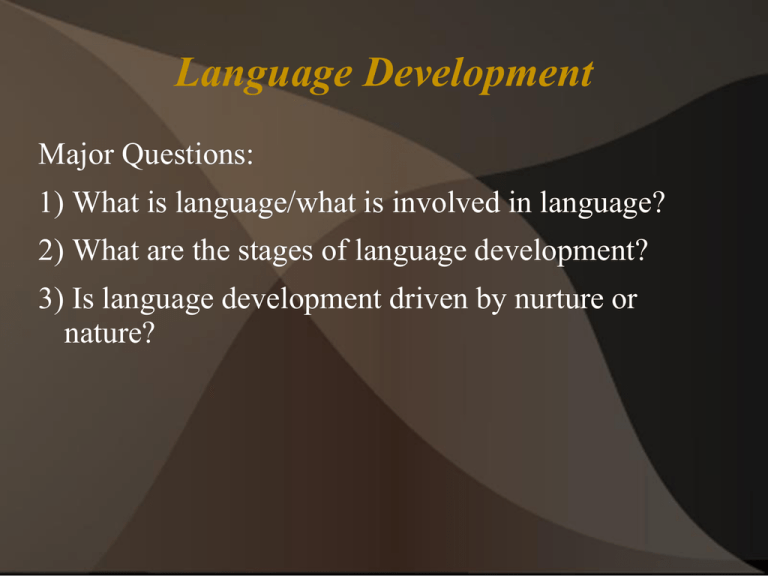
Language Development
Major Questions:
1) What is language/what is involved in language?
2) What are the stages of language development?
3) Is language development driven by nurture or
nature?
What is language?
Language has no single definition, but Hockett's list of design features is a popular
compromise. By this account, language has the following 9 attributes:
1) Mode of Communication (vocal-auditory, etc)
2) Semanticity (meaningfulness)
3) Pragmatic Function (usefulness)
4) Interchangeability (ability to function as speaker and listener)
5) Cultural Transmission (passed down)
6) Arbitrariness (no necessary relationship between sign and the signified)
7) Discreteness (made up of separable units)
8) Displacement (can refer to something in another place/time)
9) Productivity (can produce a theoretically infinite number of meaningful utterances)
Animal Communication (1)
All animal communications have the following:
mode of communication, semanticity, and pragmatic
function.
Some have interchangeability, 'cultural'
transmission, arbitrariness, and discreteness.
Essentially none have displacement and
productivity.
But there is at least one known animal language that
displays displacement – can you guess which?
Animal Communication (2)
The great and mighty Bee!
http://www.youtube.com/watch?v=4NtegAOQpSs
For our purposes, know that (human)
language:
Involves using signs that are not innately related to
the things they signify
Allows communication of concepts
Can be spoken, written, or signed (modes of
communication)
Can produce a theoretically infinite set of sentences
Seems to be unique to humans
Language learning involves (1):
Phonological development
Learn which sounds (phones) influence meaning.
These special phones are called phonemes and are the smallest
meaningful sound changes in a language.
We are able to recognize all phonemes (around 200) and
eventually our phonemic inventory narrows to match that of
languages we are exposed to (45 sounds for English)
Semantic development
Learn to manipulate minimal units of meaning, called morphemes.
Stems and affixes (prefix, suffix, infix) are two kinds of
morphemes.
Language learning involves (2):
Syntactic development
Learn the impact that the ordering of meaningful elements has on
meaning. This is called descriptive grammar.
This is NOT what we learn in school, but rather how people
actually speak. What we are taught in school is called prescriptive
grammar.
Descriptive grammar only describes the system of use;
prescriptive grammar imposes (prescribes) a particular system
Pragmatic development
Learn the rules of use, including social rules, etc.
*Meta-linguistic knowledge
This is linguistic knowledge about language: for instance,
categorizing words a noun, verb, etc. This may not actually be
necessary for language learning but is a common feature.
Language learning involves (3):
Phonological development
Semantic development
Syntactic development
Pragmatic development
*Meta-linguistic knowledge
Know these!
Methods of word learning
Fast mapping (an idea which has come under fire recently, but is still
worth discussing)
Whole object assumption ('chair' means whole, not part of the thing being
referenced)
Mutual exclusivity assumption (no thing has more than one name)
Pragmatic cues
Social context
Attention
Intentionality
Linguistic context
Syntactic bootstrapping (using syntactic rules to guess meaning in
context)
The stages of primary language
acquisition:
There are five basic stages of language acquisition
Cooing: Appears at about 6 months or so. All infants coo using all the
phonemes from every language. Even congenitally deaf children coo.
Babbling: Appears at around 9 months. Infants are starting to
selectively use the phonemes from their native language.
One-word utterances: At around 12 months, children start using
words.
Telegraphic speech: Children start making multi-word utterances that
lack function words. (about 2 years old)
Normal speech: By about 5-6 years of age, children have almost
normal speech
Nature or Nurture (1)
Skinner: Behaviorism could define the way we learn
language.
Chomsky: Human language learning appears to be
innate in a way that violate behaviorist expectations.
Called Nativism.
Nature or Nurture (2)
What about language could behaviorism not
explain?
1) Novel utterances
2) Poverty of stimulus
3) Speed of learning
4) Creolization
5) Language creation
Further evidence for Nativism
1) Neurological evidence for dedicated processing
2) Inability of other species to create linguistic
utterances even when exposed to language
3) Critical periods for language development
4) Preferential perception for speech sounds (we pay
more attention to the differences between speech and
non-speech sounds)
5) Costly physiological adaptation (larynx and
choking)
However...
Modern neural network models show some promise
for being able to demonstrate how language is
learned in a way that does not require special
equipment.
Nature AND Nurture
Both nature and nurture play valuable rolls in
language learning. For proper language
development you need a human brain and a human
environment.
